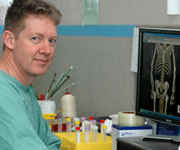A TYPICAL day for Dr Paul Bedford, a forensic pathologist at the Victorian Institute of Forensic Medicine, ranges from doing paperwork to attending murder scenes.
Dr Bedford completed his medical degree at Monash University and trained at Geelong Hospital and the Alfred Hospital, Melbourne.
He then worked as a general pathologist in Ballarat in a practice that covered large parts of western Victoria.
He joined the Victorian Institute of Forensic Medicine in early 2006 and completed the Diploma of Forensic Pathology in 2008.
Here’s how he spends a typical day:
8am Arrive at the Victorian Institute of Forensic Medicine in Southbank, Melbourne. Pathologists’ weekly meeting to discuss interesting cases, especially any homicides that have occurred in the past week. Review any cases where a pathologist is going to court and discuss what issues might be raised.
9am Read medical notes, review post-mortem CT scans for autopsies. This involves using CT scan software available to all pathologists at their terminals. Medical notes are provided by the coroner’s court and come from both hospitals and general practitioners.
10am Two post-mortem examinations performed. The first case is a middle-aged male who died after suffering chest pains, which is confirmed by the finding of coronary artery atheromatous disease. The second is a young male who sustained fatal injuries after being hit by a motor vehicle as he attempted to cross the road. This examination was undertaken for medicolegal purposes and any potential action against the driver.
Midday Finalise autopsy schedules. Download dictation files. Lunch.
1pm Discussion with the Homicide Squad re a pending committal hearing to clarify commentary in regards to a head injury from an assault that led to a person’s death. Explanations are couched in lay terms, as they will need to be explained to the judge.
2pm Review toxicology, biochemistry and histology reports of current cases. A standard group of tissue sections is taken at autopsy; in particular, to look for acute changes in the heart, lungs and brain, sometimes for chronic changes in the kidneys and liver (such as cirrhosis). Biochemistry is also useful, for example, in determining conditions such as renal failure. Toxicology will also sometimes reveal the cause of death.
3pm Meeting with a family regarding a case of sudden infant death syndrome. A difficult time for all concerned following the unexpected death of a child less than a year old. Unfortunately, these meetings do not often delineate an obvious cause of death.
4pm Reading and preparation to write an article on C-reactive protein in forensic investigations. This biochemical marker is routinely used clinically and probably also has a worthwhile function as a forensic diagnostic marker. A series of more than 100 cases is being analysed to determine the value of this test, which is cheap, reliable and easy to perform.
5pm Home
9pm Call from the tissue bank regarding a potential donor. A motor vehicle accident victim is brain dead and the family wish to donate organs, with the victim suitable for donation under corneal and skin donation protocols. Medicolegal issues are discussed, as well as any potential problems relating to the donation interfering with post-mortem analysis and investigation into the cause of death.
11pm Call from the Homicide Squad to attend a shooting death in Brunswick. The pathologist attends to help process the body, in particular, to record the types of injuries that have been sustained. This is done in consultation with the Police Forensic Services and the Homicide Squad. A post-mortem is planned for tomorrow afternoon.
3am Home. It’s been a long day.
This story will be published in MJA Careers on 7 February 2011.
Posted 24 January 2011

 more_vert
more_vert
The Institute of Forensic Medicine has an excellent man in this job. I knew him many years ago, and admired the way he worked.